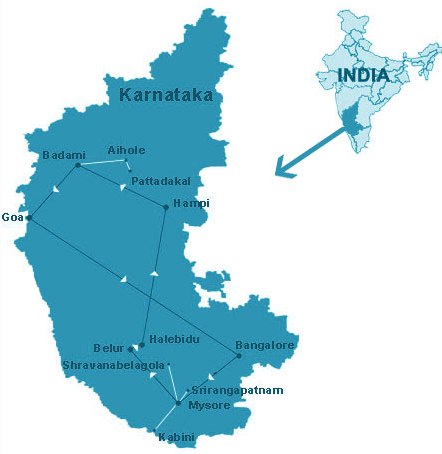Aihole
- Aihole is western chalukyan site that is situated in Karnataka.
- It was built between 450 and 650 C.E. that is situated on the banks of the river Malaprabha with the Meguti hill overlooking it.
- It was known in ancient India as Aryapur or Ayyavole and was probably the earliest capital of the Chalukyas.
- For two centuries it was at the centre of temple building.
- There are over a hundred temples in Aihole, all marking the shift from rock-cut temple architecture to a form where stone blocks are placed on top of one another.
- The oldest temple in Aihole is the Lad Khan temple.
- The Aihole Inscription is a great source for reconstructing the history of the period and it records the achievements of Pulakesi II, especially his victory against Harshavardhana, the ruler of Northern India.

- Monuments belonging to all the three religions –Hinduism, Buddhism and Jainism are found here.
- Badami and Pattadakkal are other important chalukiyan sites in its vicinity.
Farm Distress
- According to a new study, giving direct income support (DIS) to farmers may be a better option than the price deficiency payment (PDP) scheme or higher minimum support price (MSP) to address farm distress.
- DIS is easier to implement, more transparent, equitable and crop-neutral.
- The study was not in favor of higher MSPs which are based on cost plus pricing as they distort market seriously.
- The study was based on working paper authored by economist at the Indian Council for Research on International Economic Relations (ICRIER).
- ICRIER is an autonomous, policy-oriented, not-for-profit, economic policy think tank.
- ICRIER’s office is located in the institutional complex of India Habitat Centre, New Delhi.
Himalayan Yak
- The Himalayan yak (Bos mutus) is a large wild bovid native to the Himalayas.
- It is the lifeline of pastoral nomads in high altitudes of the Indian Himalayan region.
- Yaks provide nomads milk, fiber and meat.
- The long hair of yak has water-resistant properties and can be a good packing material.
- According to IUCN Red list the yak is in the vulnerable category.
- It is facing the threat of gradually rising temperatures in the region.
- Yak is accustomed to very cold temperatures and can survive up to minus 40 degrees but finds is difficult when the temperature crosses 13 degrees.
- Yak is susceptible to heat stress as it can efficiently conserve its body heat during cold weather conditions but has minimal body mechanism to dissipate heat by way of sweating.
- Yak rearing needs to be preserved as this is the only source of livelihood for nomads.
- Yak rearing is an eco-friendly livelihood for nomads who migrate to higher altitudes during summer and return to lower altitudes at about 3000 meters above sea level during winters.
- In addition to climate-related factors, there is a reduction in grazing areas and degradation of pasturelands due to various developmental activities as well.
New technique developed to monitor coastal landforms
- Indian Scientists have developed a remote sensing technique that uses satellite data to delineate between various coastal landforms like beaches, mangroves and marshes.
- This method can help monitor and understand impacts of natural disasters as well as human activities on coastal ecosystem.
- Distinguishing different landforms in coastal region remains a challenge due to their low lying nature, and absence of clear-cut boundaries between various landforms.
- Scientists have used Object-Based Image Analysis to demarcate various landforms such as ridges, marshes, mangroves etc. surrounding the Krishna delta present on East coast of India.
- This new technique deploys parameters like tone, texture, shape, context, proximity to the sea and height derived from satellite images for classification of landforms.
- Combining the values of these parameters, a total of 11 landforms were given their peculiar characteristics and were differentiated.
Probiotic Yeast Strain
- Humans face phosphorus deficiency despite consuming phosphorus-rich food because of the inability of human body to absorb it.
- Scientists at National Chemical Laboratory, Pune, have identified a yeast strain that can improve absorption of phosphorus and make other vital minerals bioavailable.
- Phosphorus is one of the vital minerals for all living beings including plants.
- Livestock and humans exhibit deficiency of phosphorus and other minerals because humans and non-ruminant animals lack an enzyme called phytase that converts phytate into free phosphorus.
- NCL researchers have identified the yeast strain called Saccharomyces cerevisiae which can effectively dephytinize the phytate to free phosphorus and also possess the probiotic properties.
- Probiotics are live bacteria and yeasts that are good for your health, especially your digestive system.
Pollution and Alzheimer's disease
- Children and young adults living in polluted megacities are at significantly increased risk of developing Alzheimer's.
- The scientists found heightened levels of the two abnormal proteins in the brains of young urbanites with lifetime exposures to fine-particulate-matter pollution (PM2.5).
- Alzheimer’s is a irreversible, progressive, degenerative brain ailment that affects memory, behavior and thinking.
- It is the most common form of dementia in the elderly and accounts for 60 to 80 per cent of dementia cases.
- India Ageing Report 2017 states that the elderly population is growing at a faster rate of 3% may up the burden of Alzheimer's in India, as the disease primarily occurs in patients over the age of 65.
- This new finding of affecting the younger generation is a precaution to the Government, Policy Makers and General Public.
Source: PIB, The Hindu, Business Line, Business standard
